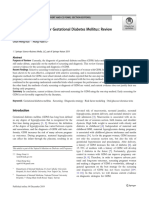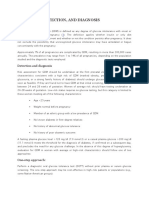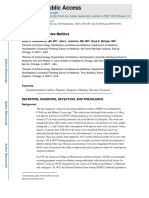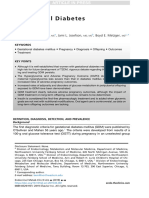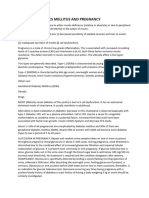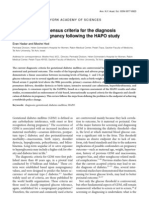Risk Factors For Fetal Macrosomia: The Importance of A Positive Oral Glucose Challenge Test
Uploaded by
Khuriyatun NadhifahRisk Factors For Fetal Macrosomia: The Importance of A Positive Oral Glucose Challenge Test
Uploaded by
Khuriyatun NadhifahEuropean Journal of Endocrinology (1997) 137 2733
ISSN 0804-4643
Risk factors for fetal macrosomia: the importance of a positive oral glucose challenge test
Giorgio Mello, Elena Parretti, Federico Mecacci, Roberto Lucchetti, Corrado Lagazio1, Monica Pratesi1 and Gianfranco Scarselli
Institute of Obstetrics and Gynecology and 1Department of Statistics G. Parenti, University of Florence, Florence, Italy (Correspondence should be addressed to G Mello, Via Masaccio, 92, 50132 Firenze, Italy)
Abstract
Objective: The aim of this study was to investigate whether minor abnormalities of glucose metabolism without gestational diabetes are a risk factor for fetal overgrowth. Design: A sample of 1883 unselected white motherinfant pairs were screened for gestational diabetes using a 50 g 1-h oral glucose challenge test (GCT) in two periods of pregnancy: early (1620 weeks) and late (2630 weeks). Methods: The effects of risk factors (glucose metabolism, previous history of mothers, obesity, multiparity and age of mothers) were estimated using a multinomial logit model. Results: The level of risk was related to gestational age at the appearance of an abnormal GCT. Patients with an abnormal GCT in the early and late periods of pregnancy (Group 1) had a risk of delivering a large for gestational age (LGA) infant seven times higher than the control group (normal GCT in both periods), and patients with a normal GCT in the early period and an abnormal GCT in the late period (Group 2) showed a risk three times higher than the control group. Among the historical risk factors for LGA infants, such as maternal obesity, multiparity, previous gestational diabetes and previous delivery of an infant weighing 4000 g or more, only the latter was associated with fetal overgrowth with a risk level 4.7 higher than the control group. Group 1 patients had a signicantly higher incidence of pregnancy-induced hypertension and preterm birth. There were no differences in the frequency of 5-min Apgar score <7 and metabolic complications among the infants of all groups. We found a signicantly higher rate of shoulder dystocia in Group 1 infants than in infants in the other groups. Conclusions: Our results suggest that a positive GCT at 2630 weeks is the most important risk factor for fetal overgrowth. This result was strongly enforced in patients who had also shown a positive early GCT at 1620 weeks. European Journal of Endocrinology 137 2733
Introduction
Maternal diabetes is only one of the factors associated with fetal overgrowth; most large for gestational age (LGA) infants are born to non-diabetic mothers. Several other conditions frequently associated with fetal overgrowth are maternal obesity, multiparity and previous delivery of an infant heavier than 4000 g (1). A positive relationship has been found between maternal prepregnancy weight and neonatal weightheight index, in both diabetic and control subjects (2). There is an increased incidence of LGA infants, not only in pregnant women who equal or exceed the threshold values dening gestational diabetes (GDM) on an oral glucose tolerance test (OGTT), but also among women exhibiting lower degrees of glucose intolerance (3). A previous study (4) showed that patients who had elevated 1-h glucose screening test values and normal OGTT results delivered macrosomic neonates
1997 Society of the European Journal of Endocrinology
signicantly more often than those with normal glucose screening results. Another report (5) showed a positive association between 1-h glucose screening test values and birth weight. Women who had only one elevated value on an OGTT had macrosomic neonates signicantly more often than those having normal glucose screens (6) and normal OGTT (7, 8). These ndings support the concept of a continuum of glucose abnormality and the thesis that an abnormal glucose challenge test (GCT) in pregnancy is a risk factor for LGA. The purpose of the present investigation was to examine rst the inuence of factors such as maternal obesity, multiparity, previous GDM, previous delivery of an infant weighing 4000 g or more and GCT results on fetal growth, and secondly to evaluate the effect of a positive GCT in the absence of GDM, both on the incidence of obstetrical complications (pregnancyinduced hypertension, intrauterine growth retardation,
28
G Mello and others
EUROPEAN JOURNAL OF ENDOCRINOLOGY (1997) 137
polyhydramnios, preterm births) and mode of delivery, and on neonatal complications (Apgar score, metabolic complications, respiratory distress syndrome, shoulder dystocia).
Materials and methods
Universal screening for GDM with the 1-h GCT is used in the antenatal unit of the Institute of Obstetrics and Gynecology of the University of Florence. The present investigation involved 1883 white motherinfant pairs screened between September 1989 and December 1992. The study received ethical approval and all the subjects gave their informed consent. Women were screened in two periods of pregnancy: early (1620 weeks) and late (2630 weeks). The screening test consisted of a 50 g oral glucose load followed by plasma determination 1 h later. If the plasma glucose level was 7.5 mmol/l or greater, a 3-h OGTT was performed within 1 week. After the fasting plasma sample was withdrawn, a 100 g oral glucose load was given and plasma samples were collected after 1, 2 and 3 h. Interpretation of OGTT results was made in accordance with the criteria established by Carpenter & Coustan (9). Anyone with an early negative GCT or an early positive GCT followed by a negative OGTT underwent a second screening test in the later period of pregnancy. All glucose determinations were conducted using the glucose oxidase method. By using a threshold of 7.5 mmol/l, we hoped to identify almost all the cases of GDM whilst avoiding the performance of a 3-h OGTT in most of our patients. Carpenter & Coustan (9) found that the screening test sensitivity at this threshold is closer to unity, that is, the proportion of gravid women with GDM missed by the screening test is reduced to nearly zero. OSullivan et al. (10) reported the prevalence of GDM among pregnant women with screening test (plasma) values below 7.9 mmol/l to be 0.7%. It is reasonable to assume that the prevalence is substantially smaller below 7.5 mmol/l. There may be uncommon occasions of patients with a test value below 7.5 mmol/l and an abnormal glucose tolerance test. In our population, the incidence of GDM was 4.4% (83 of 1883) in the early period and 7.6% (137 of 1800) in the late period. The overall incidence was therefore 11.7% (220 of 1883). In order to investigate the effect of abnormalities of glucose metabolism on fetal overgrowth, we used GCT and OGTT results to classify women into seven groups, each representing a different pattern of glucose metabolism. Group 1: patients with abnormal GCT but absence of GDM in both periods of pregnancy. Group 2: patients with normal GCT in the early period and abnormal GCT but absence of GDM in the late period.
Group 3: patients with abnormal GCT but absence of GDM in the early period and normal GCT in the late period. Group 4: patients with normal GCT in both periods. Group 5: patients with GDM in the early period. Group 6: patients with normal GCT in the early period and GDM in the late period. Group 7: patients with abnormal GCT but normal OGTT in the early period and GDM in the late period. Patients with GDM (Groups 5, 6 and 7) received their antenatal care and delivered at the Institute of Obstetrics and Gynecology of the University of Florence. All patients were taught self-monitoring of blood glucose levels with a memory-based reectance. Study participants performed a 24-h glycemic prole, consisting of one measurement every 2 h, twice a week. Insulin therapy was introduced in patients with a fasting capillary glucose level greater than 5.3 mmol/l or postprandial capillary glucose levels greater than 6.7 mmol/l. Patients were asked to return to the metabolic study unit at 2-week intervals to have adjustments made to their insulin therapy or diet mode to optimize control. Plasma glucose values during OGTT, both in early and in late pregnancy, in each of the seven groups are presented in Table 1. Several characteristics were collected at the time of the rst screening for each patient: these consisted of a sociodemographic prole and a summary of past obstetric and medical data, including traditional risk factors associated with GDM and fetal overgrowth. The previous history of the mothers identied three groups of patients: (a) patients with previous GDM; (b) patients with previous delivery of an infant weighing 4000 g or more, but in the absence of previous GDM; and (c) patients with neither previous GDM nor previous delivery of an infant weighing 4000 g or more. Obesity was dened as prepregnancy body mass index (BMI) greater than 25.0 kg/m2 (11). Multiparity was dened as a parity greater than two. Gestational age was assigned by the last menstrual period with conrmation by rst trimester ultrasound. In cases of late prenatal care, we used ultrasound to assign gestational age. In our study no patient was allowed to progress beyond 42 weeks of gestation. Infants were considered to be appropriate for gestational age (AGA) when their birth weight ranged between the 90th and the 10th percentile, LGA when their birth weight was equal to or greater than the 90th percentile and small for gestational age (SGA) when their birth weight was equal to or less than the 10th percentile on the basis of growth standards developed for our population (12). Some descriptive statistics of maternal characteristics and neonatal outcomes are reported in Table 2. In order to meet the second aim of the analysis, pregnancies were considered to be complicated in the presence of pregnancy-induced hypertension, intrauterine growth retardation, polyhydramnios and preterm delivery. Criteria for the diagnosis of
EUROPEAN JOURNAL OF ENDOCRINOLOGY (1997) 137
Fetal macrosomia and testing
29
Table 1 Mean S.D. glucose plasma values (mmol/l) in early (1620 weeks) and late (2630 weeks) GCT and OGTT tests. Glucose plasma (mmol/l) Group 1 Early period GCT after 1 h OGTT initial value OGTT after 1 h OGTT after 2 h OGTT after 3 h Late period GCT after 1 h OGTT initial value OGTT after 1 h OGTT after 2 h OGTT after 3 h 8:5 0:8 4:6 0:4 8:1 1:2 6:7 1:0 5:6 3:3 8:7 0:9 4:7 0:4 8:6 1:1 7:3 1:0 5:9 1:1 Group 2 6:3 0:9 8:3 0:8 4:6 0:4 8:4 1:2 7:0 1:0 5:8 2:4 Group 3 8:2 0:5 4:6 0:5 7:3 1:4 6:4 1:1 5:3 1:2 6:6 0:7 Group 4 5:6 1:5 6:2 0:9 Group 5 9:3 1:3 5:1 0:6 11:0 1:3 9:4 1:1 7:0 1:6 Group 6 6:4 1:1 8:8 0:9 5:0 0:5 10:7 1:1 9:4 1:1 7:1 1:6 Group 7 8:7 0:9 4:7 0:5 8:9 1:3 6:9 1:1 5:4 1:4 9:7 1:3 5:1 0:6 10:9 1:2 9:4 1:2 7:0 1:5 Total 6:4 1:7 4:8 0:5 8:8 1:8 7:4 1:6 5:9 2:6 7:1 1:5 4:7 0:5 8:9 1:5 7:6 1:4 6:1 2:1
pregnancy-induced hypertension were based on the classication of Davey & MacGillivray (13). Diagnosis of intrauterine growth retardation was based on a pathologic decrease in the rate of fetal growth (14). Polyhydramnios was dened as an amniotic uid index greater than the 95th percentile for gestational age (15). Any delivery occurring before 37 completed weeks from the rst day of the last menstrual period was considered to be a preterm birth (16). Neonatal complications considered in the study were: 5-min Apgar score <7, hyperbilirubinemia, hypocalcemia, hypoglycemia, respiratory distress syndrome, shoulder dystocia. Hypoglycemia (capillary heel blood) was diagnosed if any two consecutive values of plasma glucose were less than 1.7 mmol/l. Hyperbilirubinemia was characterized by plasma values equal to or greater than 204 mmol/l. Hypocalcemia (equal to or less than 1.7 mmol/l) was assessed when clinically indicated (jitters, tremors, etc.). The diagnosis of respiratory distress syndrome was based on clinical signs, blood gas values, need for respiratory assistance, and X-ray ndings typical of this syndrome. None of the newborns were born from multiple pregnancies or had congenital anomalies and there were no macrosomic newborns (birth weight greater than 4000 g) associated with post-date (more than 42 weeks) pregnancies.
Statistical analysis
The rst aim of the analysis was to assess the effects of the risk factors on the distribution of infants among the three fetal growth categories (AGA, LGA, SGA). Since the response variable is classied on three nominal levels we used a multinomial logit model to evaluate the inuence of the risk factors on fetal overgrowth (17). The risk factors involved in the specication of the model were glucose metabolism (seven different patterns identied by the previous classication), previous history of the mothers, obesity, multiparity and mothers older than 35 years.
In our specication of the model the reference category of the response variable was the AGA class. Therefore the inuence of risk factor levels on fetal overgrowth can be read through two parameters: one contrasting LGA with AGA infants, the other SGA with AGA infants. The parameter associated with a level of a risk factor can be interpreted as the logarithm of the odds ratio between that level and the reference category. The odds are the probability of being LGA (or SGA) over the probability of being AGA, given the level of the risk factor. Therefore, the risk of fetal overgrowth can be measured by the exponential of the parameter value. An odds ratio greater than 1 indicates a higher relative frequency of LGA (or SGA) for the corresponding risk factor level with respect to the reference category. The model selection (i.e. the choice of signicant factors) was based on the likelihood ratio test; condence intervals for each odds ratio were constructed using the normal approximation. Single odds ratios are considered statistically signicant if the correspondent 95% condence interval does not cover unity. The application was conducted using the GLIM package (18). In order to evaluate the effect of a positive GCT in the absence of GDM on maternal (pregnancy-induced hypertension, intrauterine growth retardation, polyhydramnios, preterm birth, operative delivery) and neonatal (Apgar score, metabolic complications, respiratory distress syndrome, shoulder dystocia) outcomes, attention was focused on the rst four groups previously dened on the basis of GCT and OGTT results. Differences in incidence of maternal and neonatal complications among groups were evaluated with x2 analysis and Fishers exact tests. Statistical signicance was dened as P<0.05.
Results
Table 3 shows the odds ratios and the 95% condence intervals for each level of the factors considered.
30
G Mello and others
EUROPEAN JOURNAL OF ENDOCRINOLOGY (1997) 137
Table 2 Maternal and neonatal characteristics.
Maternal characteristics Maternal age (year; S.D.) Maternal age > 35 years (%) Multiparity (%) BMI (kg/m2 ; S.D.) Obesity (%) Maternal birth weight 4000 g (%) Previous macrosomia (%) Previous GDM (%) Family history of diabetes (%)
Different patterns of glucose metabolism and the previous history of mothers showed a signicant inuence on birth weight, while multiparity, obesity and age of mothers seemed not to be signicant factors. The interactions between all the considered factors were not statistically signicant and are not reported in Table 3. Patients belonging to Groups 1, 2 and 6 showed a signicant increase in the risk of fetal overgrowth (LGA) with respect to patients with normal glucose metabolism (reference category). The highest level of risk was achieved by patients in Group 1: the estimated odds ratio indicated a risk seven times higher than in the control group. This high level was not due to the higher incidence of previous GDM and the higher maternal age of patients in Group 1 (see Table 2), since the parameters measuring the interaction between glucose metabolism and previous history and age of mothers were not signicant. Patients with previous delivery of an infant of 4000 g or more showed a risk 4.7 times greater than patients having a normal history. In our analysis, the absence of interactions between glucose metabolism and the previous history of the mothers indicated that the risk due to previous delivery of an infant of 4000 g or more does not signicantly differ among groups. Obstetrical complications, mode of delivery and neonatal complications of Groups 1, 2, 3 and 4 (control group) are shown in Table 4. Patients of Group 1 had a signicantly higher incidence of pregnancy-induced hypertension. Comparable rates of intrauterine growth retardation and polyhydramnios were found between the four groups. A signicantly higher rate of preterm births was found in Group 1 compared with Group 3 and the control group. There was no signicant difference in the frequency of normal spontaneous delivery, Cesarean section and vacuum extraction. There was no difference in the frequency of 5-min Apgar scores <7. Comparison of metabolic complications, such as hyperbilirubinemia, hypocalcemia and hypoglycemia revealed no signicant differences among the four groups. No signicant difference was found also in the incidence of respiratory distress syndrome. There was a signicantly higher risk for shoulder dystocia for the infants of Group 1 compared with those of the control group.
39:7 1:7 3303 485 14.7 82.0 3.3 39:3 1:7 3220 570 12.3 82.5 5.3 39:4 1:3 3315 433 16.3 82.5 1.3 39:5 1:3 3251 455 9.6 85.5 4.8 39:7 1:5 3248 449 8.3 87.5 4.2 39:7 1:2 3427 401 17.6 82.4 0.0 39:6 2:1 3358 510 21.8 76.4 1.8 39:7 2:7 3537 573 40.2 58.6 1.2 Neonatal characteristics Age at delivery (weeks; S.D.) Weight (g; S.D.) LGA (%) AGA (%) SGA (%)
30:4 5:3 18.2 2.34 22:4 3:8 14.3 15.6 1.1 1.5 36.2
Total
33:3 5:8 40.4 5.3 23:5 4:4 22.8 17.5 1.8 5.3 38.6
Group 7
30:8 4:6 16.3 5.0 22:7 2:9 21.3 13.8 0.0 1.3 38.8
Group 6
33:7 5:1 37.6 7.2 23:4 6:5 30.1 12.1 2.4 2.4 45.8
Group 5
29:4 5:2 13.3 1.5 21:9 3:4 11.6 15.5 0.9 0.5 34.3
Group 4
30:7 5:6 20.6 0.0 23:4 4:9 20.6 26.5 0.0 0.1 35.3
Group 3
30:9 4:8 18.0 2.5 22:5 3:8 14.2 16.2 1.0 2.8 37.0
Group 2
32:6 5:2 32.2 2.9 23:2 3:9 16.1 14.9 2.3 2.9 39.1
Group 1
174
395
34
1060
83
80
57
1883
Discussion
The results of this study are consistent with previous reports that minor abnormalities of glucose metabolism without GDM are a signicant risk factor for fetal overgrowth (3, 4, 68, 19). The level of risk is related to gestational age at the onset of abnormal maternal glucose metabolism. Patients with abnormal GCT in the early and late periods of pregnancy (Group 1) had a risk of LGA infants seven times higher than the control
Number of cases
EUROPEAN JOURNAL OF ENDOCRINOLOGY (1997) 137
Fetal macrosomia and testing
31
Table 3 Odds ratios (OR) with 95% condence intervals (CI) obtained from multinomial logit model for the associations between selected variable and fetal growth. LGA Parameter Glucose metabolism Group 1 Group 2 Group 3 Group 4 Group 5 Group 6 Group 7 Previous history of mothers Normal Previous gestational diabetes Previous delivery infant > 4000 g Obesity No Yes Multiparity No Yes Maternal age > 35 years No Yes
a
SGA 95% CI OR 95% CI
OR
7.06 3.04 2.38 1.00 1.03 2.09 1.45 1.00 0.60 4.74 1.00 1.03 1.00 2.10 1.00 1.22
4.7710.44 2.174.25 0.946.02 0.462.30 1.094.00 0.613.41
0.42 0.49 a 1.00 1.18 0.31 1.39 1.00 a a 1.00 1.24 1.00 0.89 1.00 0.95
0.101.81 0.211.11 a 0.393.52 0.042.37 0.404.87
0.201.87 1.7512.85
a a
0.701.51
0.612.55
0.994.46
0.117.37
0.871.72
0.452.00
Not estimated because of lack of observations.
group and patients with normal GCT in the early period and abnormal GCT in the late period (Group 2) showed a risk three times greater than the control group. The patients of Group 3 did not differ signicantly from the control group. Our results suggest that a positive GCT at 2630 weeks is the most important risk factor for fetal overgrowth. This result is strongly
enforced in patients who also have a positive early GCT at 1620 weeks. The current study supports the consideration of a positive 1-h glucose screen itself as a marker of abnormal carbohydrate metabolism with effects on fetal growth. Leikin et al. (4) showed that minor carbohydrate intolerance in subjects with an elevated
Table 4 Maternal complications, mode of delivery and neonatal complications. Group 1 Maternal complications Pregnancy-induced hypertension (%) Intrauterine growth retardation (%) Polyhydramnios (%) Preterm birth (%) Modes of delivery Normal spontaneous delivery (%) Operative delivery (%) Cesarean section Vacuum extraction Neonatal complications Metabolic complications (%) Hyperbilirubinemia Hypocalcemia Hypoglycemia Respiratory distress syndrome Shoulder dystocia
a
Group 2
Group 3
Group 4
2.9a 0.6 0.0 8.0b 81.0 16.1 2.9
1.5 0.5 0.5 5.3 76.2 20.0 3.8
0.0 0.0 0.0 2.9 73.5 23.5 2.9
0.6 1.6 0.1 4.3 80.5 16.1 3.4
4.0 0.0 2.3 2.3 1.7c
4.8 0.5 0.6 0.6 0.5
0.0 0.0 0.0
3.1 0.5 0.7 1.5 0.3
P < 0:01, Group 1 vs Group 4; b P < 0:05, Group 1 vs Groups 3 and 4; c P < 0:05, Group 1 vs Group 4.
32
G Mello and others
EUROPEAN JOURNAL OF ENDOCRINOLOGY (1997) 137
glucose screen but normal OGTT was associated with delivery of macrosomic infants, even after correcting for other variables associated with macrosomia. Another report showed positive association between 1-h glucose screen test values and birth weight (5). Berkus et al. (20) have also found that patients with abnormal 50 g screen values but normal OGTT had signicantly higher insulin output and insulinglucose ratios than those with normal GCT. Landy et al. (21) have shown that a glucose screen above 103 mmol/l is associated with a probable diagnosis of GDM and predictive of neonatal macrosomia and hypoglycemia in their patient population and suggested the use of this approach in the diagnosis of GDM without using the 3-h OGTT. Both mothers with GDM in the early period (Group 5) and those with an abnormal GCT but a normal OGTT in the early period and GDM in the late period (Group 7) showed rates of LGA infants not signicantly higher than the control group; this may occur because of the higher proportion of women treated with insulin in Group 5 and Group 7 (711% and 614% respectively). In contrast, mothers with normal GCT in the early period and GDM in the late period (Group 6) showed a risk 21 times greater than the control group probably because of the lower proportion (163%) of women treated with insulin. These ndings, as well as those from other studies (22, 23), suggest that insulin therapy may have contributed to the prevention of fetal overgrowth in our subjects, lowering the rate of LGA infants independently of the period of the onset of abnormal maternal glucose metabolism (23). Among the historical risk factors for LGA infants such as multiparity, obesity, previous GDM and previous delivery of an infant weighing 4000 g or more, only the latter was associated with fetal overgrowth when controlling for glucose metabolism, with a level of risk 47 times greater than the reference group. The high frequency of increased birth weights in subsequent pregnancies is well accepted. Bakketeig et al. (24) found that the incidence of an LGA infant was 479% in the second birth if the rst was LGA, compared with 188% if the rst birth was AGA. Our nding of an increased risk of pregnancy-induced hypertension in Group 1 is consistent with the ndings of Lindsay et al. (6) who observed a signicant increase in the incidence of this complication in women with minor degrees of maternal glucose intolerance. Cesarean delivery rates were similar in Group 1 and the control group despite very different LGA rates between the two groups. This may be because of our policy of performing elective Cesarean section for all infants with an estimated weight greater than or equal to 4250 g: among the 70 LGA infants of Group 1, only 6 (86%) (data not shown) had a birth weight above this threshold. A threefold higher rate of shoulder dystocia was found in Group 1 compared with the other two groups. This fact may be related to the higher incidence of LGA infants in this group.
References
1 Modanlou HD, Dorchester WL, Thorosian A & Freeman RK. Macrosomia: maternal, fetal, and neonatal implication. Obstetrics and Gynecology 1980 55 420424. 2 Vohr BR, Lipsitt LP & Oh W. Somatic growth of children of diabetic mothers with reference to birth size. Pediatrics 1980 97 196199. 3 Weiner CP. Effect of varying degrees of normal glucose metabolism on maternal and perinatal outcome. American Journal of Obstetrics and Gynecology 1988 159 862870. 4 Leikin EL, Jenkins JH, Pomarantz GA & Klein L. Abnormal glucose screening tests in pregnancy: a risk factor for fetal macrosomia. Obstetrics and Gynecology 1987 69 570573. 5 Green JR, Schumacher LB, Pawson IG, Partridge JC & Kretchmer N. Inuence of maternal body habitus and glucose tolerance on birth weight. Obstetrics and Gynecology 1991 78 235240. 6 Lindsay MK, Graves W & Klein L. The relationship of one abnormal glucose tolerance test value and pregnancy complications. Obstetrics and Gynecology 1989 73 103106. 7 Langer O, Anyaegbunam A, Brustman L & Divon M. Management of women with one abnormal oral glucose tolerance test value reduces adverse outcome in pregnancy. American Journal of Obstetrics and Gynecology 1989 161 593599. 8 Kaufmann RC, McBridge P, Amankwah KS & Huffman DG. The effect of minor degrees of glucose intolerance on the incidence of neonatal macrosomia. Obstetrics and Gynecology 1992 80 97101. 9 Carpenter MW & Coustan DR. Criteria for screening tests for gestational diabetes. American Journal of Obstetrics and Gynecology 1982 144 768773. 10 OSullivan JB, Mahan CM, Charles D & Dandrow RW. Screening criteria of high risk gestational diabetic patients. American Journal of Obstetrics and Gynecology 1973 116 895900. 11 IOM (Institute of Medicine). Committee on Nutritional Status during Pregnancy and Lactation, National Academy of Sciences. Washington, DC: National Academy Press, 1990. 12 Panero C, Romano S, Cianciulli D, Carbone C, Gizdulich P, Bettini F, Mainardi G, Vergallo G, Veneruso G, Bacicchi A & Gracci L. Auxometric parameters and gestational age in 9,751 newborns in Florence (Italy). Journal of Foetal Medicine 1983 III 34 95103. 13 Davey DA & MacGillivray I. The classication and denition of the hypertensive disorders of pregnancy. American Journal of Obstetrics and Gynecology 1988 158 892898. 14 Altman DG & Hytten FE. Intrauterine growth retardation: lets be clear about it. British Journal of Obstetrics and Gynaecology 1989 96 11271128. 15 Moore TK & Layle TE. The amniotic uid index in normal pregnancy. American Journal of Obstetrics and Gynecology 1990 162 11681173. 16 World Health Organization. Prevention of Perinatal Morbidity and Mortality. Public Health Papers 42. Geneva: WHO, 1969. 17 MacCullagh B & Nelder JA. Generalized Linear Model. London: Chapman and Hall, 1989. 18 Francis B, Green M & Payne C (Eds). The GLIM system: Generalized Linear Interactive Modelling, Release 4 Manual. Oxford: Oxford University Press, 1993. 19 Langer O, Brustman L, Anyaegbunam & Mazze R. The signicance of one abnormal glucose tolerance test value on adverse outcome in pregnancy. American Journal of Obstetrics and Gynecology 1987 157 758763. 20 Berkus MD, Stern MP, Abashawl A & Langer O. Relationships between glucose levels and insulin secretion during a glucose challenge test. American Journal of Obstetrics and Gynecology 1990 163 18181822. 21 Landy HJ, Gomez-Marin O & OSullivan MJ. Diagnosing gestational diabetes mellitus: use of a glucose screen without administering the glucose tolerance test. Obstetrics and Gynecology 1996 87 395400.
EUROPEAN JOURNAL OF ENDOCRINOLOGY (1997) 137
Fetal macrosomia and testing
33
22 Coustan DR & Imarah J. Prophilactic insulin treatment of gestational diabetes reduces the incidence of macrosomia, operative delivery, and birth trauma. American Journal of Obstetrics and Gynecology 1984 150 836842. 23 Buchanan TA, Kisos SL, Montero MN, Wu PYK, Mashilejo NG, Gonzales M, Nunez V, Pantoya PM & Xlang A. Use of fetal ultrasound to select metabolic therapy for pregnancies complicated by mild gestational diabetes. Diabetes Care 1994 17 275282.
24 Bakketeig CS, Hoffman HJ & Harley EE. The tendency to repeat gestational age and birth weight in successive births. American Journal of Obstetrics and Gynecology 1979 135 10861103.
Received 24 June 1996 Accepted 27 February 1997
You might also like
- Complementary and Alternative Medical Lab Testing Part 10: ObstetricsFrom EverandComplementary and Alternative Medical Lab Testing Part 10: ObstetricsNo ratings yet
- 17 Diagnostic Strategies For Gestational Diabetes MellitusreviewNo ratings yet17 Diagnostic Strategies For Gestational Diabetes Mellitusreview10 pages
- Single-Step DIPSI 75g Glucose Tolerance Test-For Diagnosis of Gestational Diabetes MellitusNo ratings yetSingle-Step DIPSI 75g Glucose Tolerance Test-For Diagnosis of Gestational Diabetes Mellitus7 pages
- Gestational-Diabetes-Screening-Strategies,-Glycemic-Targets-and-Pharmacologic-Management-OB-Consensus-ConferenceNo ratings yetGestational-Diabetes-Screening-Strategies,-Glycemic-Targets-and-Pharmacologic-Management-OB-Consensus-Conference13 pages
- Gestational Diabetes : Sensitivity, Specificity and Diagnostic Accuracy of Glucose Challenge Test in DiagnosisNo ratings yetGestational Diabetes : Sensitivity, Specificity and Diagnostic Accuracy of Glucose Challenge Test in Diagnosis7 pages
- Vol 17 Endocrinology Committee NewsletterNo ratings yetVol 17 Endocrinology Committee Newsletter15 pages
- Perfil de Gestantes Com Diabetes Mellitus GestacionalNo ratings yetPerfil de Gestantes Com Diabetes Mellitus Gestacional8 pages
- Correlations Between Parameters of Glycaemic Variability and Foetal Growth Neonatal Hypoglycaemia and Hyperbilirubinemia in Women With Gestational diabetesPLoS ONENo ratings yetCorrelations Between Parameters of Glycaemic Variability and Foetal Growth Neonatal Hypoglycaemia and Hyperbilirubinemia in Women With Gestational diabetesPLoS ONE14 pages
- J of Obstet and Gynaecol - 2011 - Olmos - Gestational Diabetes and Pre Pregnancy Overweight Possible Factors Involved inNo ratings yetJ of Obstet and Gynaecol - 2011 - Olmos - Gestational Diabetes and Pre Pregnancy Overweight Possible Factors Involved in7 pages
- Diagnosis and Treatment of Dyslipidemia in PregnancyNo ratings yetDiagnosis and Treatment of Dyslipidemia in Pregnancy13 pages
- HHS Public Access: Gestational Diabetes MellitusNo ratings yetHHS Public Access: Gestational Diabetes Mellitus19 pages
- Standards of Medical Care in Diabetes - 2010: Iii. Detection and Diagnosis of GDMNo ratings yetStandards of Medical Care in Diabetes - 2010: Iii. Detection and Diagnosis of GDM4 pages
- Influence of Maternal Weight Gain On Birth Weight: A Gestational Diabetes CohortNo ratings yetInfluence of Maternal Weight Gain On Birth Weight: A Gestational Diabetes Cohort9 pages
- High Maternal Hba Is Associated With Overweight In Neonates: Dan Med Bul Ϧϫ/ϪNo ratings yetHigh Maternal Hba Is Associated With Overweight In Neonates: Dan Med Bul Ϧϫ/Ϫ6 pages
- The Hyperglycemia and Adverse Pregnancy Outcome Study: (HAPO)No ratings yetThe Hyperglycemia and Adverse Pregnancy Outcome Study: (HAPO)9 pages
- Critical Evaluation of The Diagnosis of Gestational Diabetes Mellitus (GDM)No ratings yetCritical Evaluation of The Diagnosis of Gestational Diabetes Mellitus (GDM)23 pages
- Complementary and Alternative Medical Lab Testing Part 18: PsychiatryFrom EverandComplementary and Alternative Medical Lab Testing Part 18: Psychiatry5/5 (1)
- Complementary and Alternative Medical Lab Testing Part 9: GynecologyFrom EverandComplementary and Alternative Medical Lab Testing Part 9: GynecologyNo ratings yet
- A Practical Manual of Diabetes in PregnancyFrom EverandA Practical Manual of Diabetes in PregnancyDavid McCanceNo ratings yet
- Effect of Glimepiride Compared With Glibenclamide On Post Prandial Blood Sugar in Type II Diabetes Mellitus PatientsNo ratings yetEffect of Glimepiride Compared With Glibenclamide On Post Prandial Blood Sugar in Type II Diabetes Mellitus Patients4 pages
- Risk Factors For Macrosomia in Infants Born To Latina Women: Original ArticleNo ratings yetRisk Factors For Macrosomia in Infants Born To Latina Women: Original Article7 pages
- Adverse Maternal Outcomes Associated With Fetal Macrosomia: What Are The Risk Factors Beyond Birthweight?No ratings yetAdverse Maternal Outcomes Associated With Fetal Macrosomia: What Are The Risk Factors Beyond Birthweight?6 pages
- Risk Factors For Fetal Macrosomia: The Importance of A Positive Oral Glucose Challenge TestNo ratings yetRisk Factors For Fetal Macrosomia: The Importance of A Positive Oral Glucose Challenge Test7 pages
- Macrosomia Risk Factors and Labor Outcome Methal-A. Alrubae, Klood JaferNo ratings yetMacrosomia Risk Factors and Labor Outcome Methal-A. Alrubae, Klood Jafer8 pages
- Maternal Waist To Hip Ratio Is A Risk Factor For Macrosomia: EpidemiologyNo ratings yetMaternal Waist To Hip Ratio Is A Risk Factor For Macrosomia: Epidemiology7 pages
- Complementary and Alternative Medical Lab Testing Part 10: ObstetricsFrom EverandComplementary and Alternative Medical Lab Testing Part 10: Obstetrics
- 17 Diagnostic Strategies For Gestational Diabetes Mellitusreview17 Diagnostic Strategies For Gestational Diabetes Mellitusreview
- Single-Step DIPSI 75g Glucose Tolerance Test-For Diagnosis of Gestational Diabetes MellitusSingle-Step DIPSI 75g Glucose Tolerance Test-For Diagnosis of Gestational Diabetes Mellitus
- Gestational-Diabetes-Screening-Strategies,-Glycemic-Targets-and-Pharmacologic-Management-OB-Consensus-ConferenceGestational-Diabetes-Screening-Strategies,-Glycemic-Targets-and-Pharmacologic-Management-OB-Consensus-Conference
- Gestational Diabetes : Sensitivity, Specificity and Diagnostic Accuracy of Glucose Challenge Test in DiagnosisGestational Diabetes : Sensitivity, Specificity and Diagnostic Accuracy of Glucose Challenge Test in Diagnosis
- Perfil de Gestantes Com Diabetes Mellitus GestacionalPerfil de Gestantes Com Diabetes Mellitus Gestacional
- Correlations Between Parameters of Glycaemic Variability and Foetal Growth Neonatal Hypoglycaemia and Hyperbilirubinemia in Women With Gestational diabetesPLoS ONECorrelations Between Parameters of Glycaemic Variability and Foetal Growth Neonatal Hypoglycaemia and Hyperbilirubinemia in Women With Gestational diabetesPLoS ONE
- J of Obstet and Gynaecol - 2011 - Olmos - Gestational Diabetes and Pre Pregnancy Overweight Possible Factors Involved inJ of Obstet and Gynaecol - 2011 - Olmos - Gestational Diabetes and Pre Pregnancy Overweight Possible Factors Involved in
- Diagnosis and Treatment of Dyslipidemia in PregnancyDiagnosis and Treatment of Dyslipidemia in Pregnancy
- Standards of Medical Care in Diabetes - 2010: Iii. Detection and Diagnosis of GDMStandards of Medical Care in Diabetes - 2010: Iii. Detection and Diagnosis of GDM
- Influence of Maternal Weight Gain On Birth Weight: A Gestational Diabetes CohortInfluence of Maternal Weight Gain On Birth Weight: A Gestational Diabetes Cohort
- High Maternal Hba Is Associated With Overweight In Neonates: Dan Med Bul Ϧϫ/ϪHigh Maternal Hba Is Associated With Overweight In Neonates: Dan Med Bul Ϧϫ/Ϫ
- The Hyperglycemia and Adverse Pregnancy Outcome Study: (HAPO)The Hyperglycemia and Adverse Pregnancy Outcome Study: (HAPO)
- Critical Evaluation of The Diagnosis of Gestational Diabetes Mellitus (GDM)Critical Evaluation of The Diagnosis of Gestational Diabetes Mellitus (GDM)
- Complementary and Alternative Medical Lab Testing Part 18: PsychiatryFrom EverandComplementary and Alternative Medical Lab Testing Part 18: Psychiatry
- Complementary and Alternative Medical Lab Testing Part 9: GynecologyFrom EverandComplementary and Alternative Medical Lab Testing Part 9: Gynecology
- Effect of Glimepiride Compared With Glibenclamide On Post Prandial Blood Sugar in Type II Diabetes Mellitus PatientsEffect of Glimepiride Compared With Glibenclamide On Post Prandial Blood Sugar in Type II Diabetes Mellitus Patients
- Risk Factors For Macrosomia in Infants Born To Latina Women: Original ArticleRisk Factors For Macrosomia in Infants Born To Latina Women: Original Article
- Adverse Maternal Outcomes Associated With Fetal Macrosomia: What Are The Risk Factors Beyond Birthweight?Adverse Maternal Outcomes Associated With Fetal Macrosomia: What Are The Risk Factors Beyond Birthweight?
- Risk Factors For Fetal Macrosomia: The Importance of A Positive Oral Glucose Challenge TestRisk Factors For Fetal Macrosomia: The Importance of A Positive Oral Glucose Challenge Test
- Macrosomia Risk Factors and Labor Outcome Methal-A. Alrubae, Klood JaferMacrosomia Risk Factors and Labor Outcome Methal-A. Alrubae, Klood Jafer
- Maternal Waist To Hip Ratio Is A Risk Factor For Macrosomia: EpidemiologyMaternal Waist To Hip Ratio Is A Risk Factor For Macrosomia: Epidemiology

